 |
[ Outlaw Genealogy | Bruce
History | Lost Chords ] [ Projects | News | FAQ | Suggestions | Search | HotLinks | Resources | Ufo ] |
 |
[ Outlaw Genealogy | Bruce
History | Lost Chords ] [ Projects | News | FAQ | Suggestions | Search | HotLinks | Resources | Ufo ] |
Well let's start with the first connection Hubert De Burgh, The Outlaw's family early patron is/was buried at Blackfriars:
1207 - Hubert
de Burgh purchased of Roger de Burnham and Julian, his wife, William de
Noiers, Robert Fitz Ralph, and Alice his wife, and Robert de Utlagh,
their several nine parts of two knights fees in Runton and Beeston and
Hinderingham, for which they paid castle gaurd to Dover. 9th of King John *The
Norfolk antiquarian miscellany - Google Books - West
Runton - Beeston
Regis - Hindringham
1207 - Alan
the son of Robert de Vtlage, granted the land of Beston and Runton to
the Prior of Walsingham by deed , sans date, bounded as there.
Hubert de Burgh, 1st Earl of Kent - (c. 1160 – before 5 May 1243) was Earl of Kent, Justiciar of England and Ireland, and one of the most influential men in England during the reigns of John and Henry III. ...After the death of William Marshal in 1219, Hubert de Burgh effectively became regent of England. In this position de Burgh acquired a number of enemies and rivals. ... He died in 1243 in Banstead, Surrey, England and was buried at the church of the Black Friars in Holborn.
| - - - - -
One of the other connections is Sir Francis Bryan who was the boss of Adam Outlawe, Trinity House Mariner, He is given Blackfriars by Henry VIII's son around 1547 - What is interesting are the allegations that he was a master of the Rosicrucian's prior to John Dee , that he was King Henry VIII's spy master. ...
BRYAN, Sir Francis (by 1492-1550), of the Blackfriars, London and Ampthill and Woburn, Beds.
With Henry VIII’s death Bryan’s own career entered its last phase: no longer a court favourite (although his mother was ‘lady mistress’ of the new King’s household) he remained a considerable figure, not least by reason of his landed wealth which was assessed for subsidy at £888 a year. In May 1547 he was granted the keepership of six royal parks in Bedfordshire, to be held for life, in each case with one other grantee who probably acted as his deputy. For his part in the Protector Somerset’s expedition against Scotland in September Bryan was created a knight banneret, and in the following year he was granted the bishop’s palace at Norwich and given continued tenancy of extensive parts of the Blackfriars in London ...
All
the year round a weekly journal - Charles Dickens
...
The rapacious king laid his rough hand on the treasures of the house in 1538,
and Edward the Sixth sold the Hall and Prior's Lodgings to Sir Francis
Bryan, a courtier, afterwards granting Sir Francis
Cawarden, master of the revels, the whole house and precincts of the
Preacher Friars, the yearly value being then reckened at nineteen pounds.
The holy brothers were dispersed to beg or thieve, and the church was pulled
down, but the mischievous right of sanctuary continued.
Shakespeare’s
property in Blackfriars
...
After the dissolution of the Blackfriars monastery in 1538, its land and
buildings had been parcelled out to ambitious courtiers. The estate of which
Shakespeare’s property formed part was granted in 1547 to Sir Francis Bryan,
dubbed “The Vicar of Hell” by Thomas Cromwell.
After Bryan’s death in 1550 it came into the hands of Thomas Thirlby, Bishop of Norwich, later Bishop of Ely, who then sold it to William Blackwell, Common Clerk of the City of London.
1543 - Westminster., 19 Feb. showing Sir Francis Bryan that the King is advertised of the troubles we were in upon the seas and the danger and ruin of his ships, and that I was determined according to your commandment to send four ships to the Downes. The said ships were ready in Humber before the receipt of your letters, whereupon I sent a boat which has spoken with Mr. Clere and Mr. Carye, commanding them to lie off and on upon the coast between Humber and Newcastle, and as Mr. Nedygate and Adam Owtlawe were ready victualled I thought it more convenient that they should accompany Mr. Clere and Mr. Carye, than lie in harbour.
| - - - - -
Then we have Richard Outlawe Pursuivant to Queen Elizabeth I , Pursuivant to the President of the North (York) whose presumed son, William Outlawe goes to the first Protestant spiritual college and ends up in King James I religious closet while the King James Bible is being written...
1595 - Queen
Elizabeth's Counsel at York - Richard Outlawe the pursuivant attending
-
William
Outlaw,
the pursuivant's son (Pursuivant - Queen's Messenger)
1601 - WILLIAM OUTLAWE matriculated Emmanuel College, 1601.
1614 - March 6. Statement by Leonard Rountree of four articles to prove the superiority of the Protestant over the Romish faith, which were sent to him by Dr. Favour; of his replies thereto; and conversations upon them with William Outlaw, Mr. Burton, and Mr. Harwood.
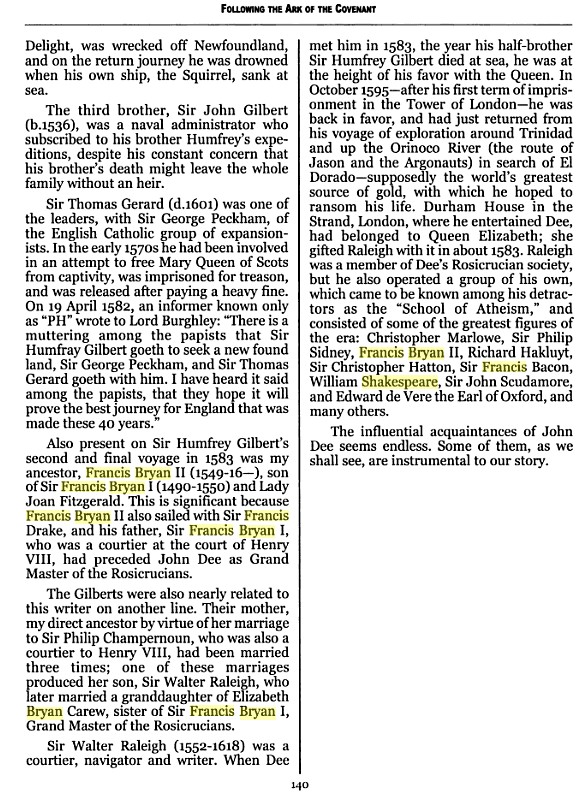
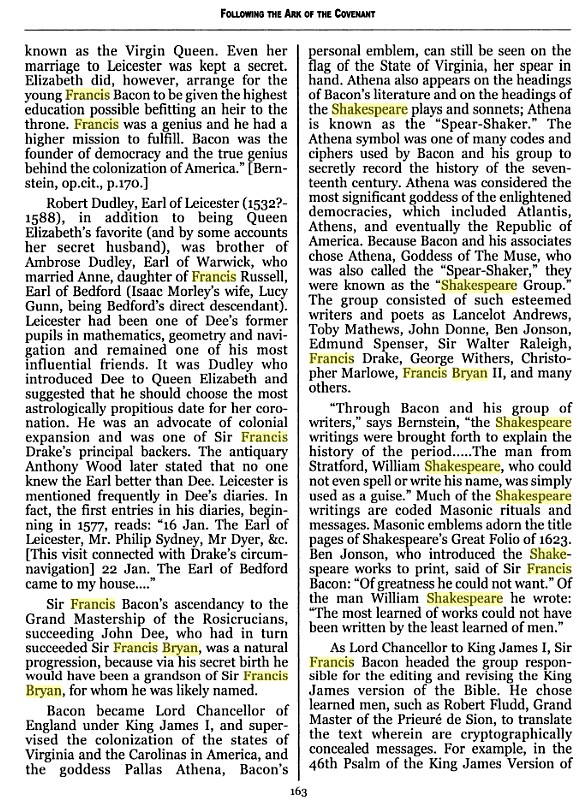
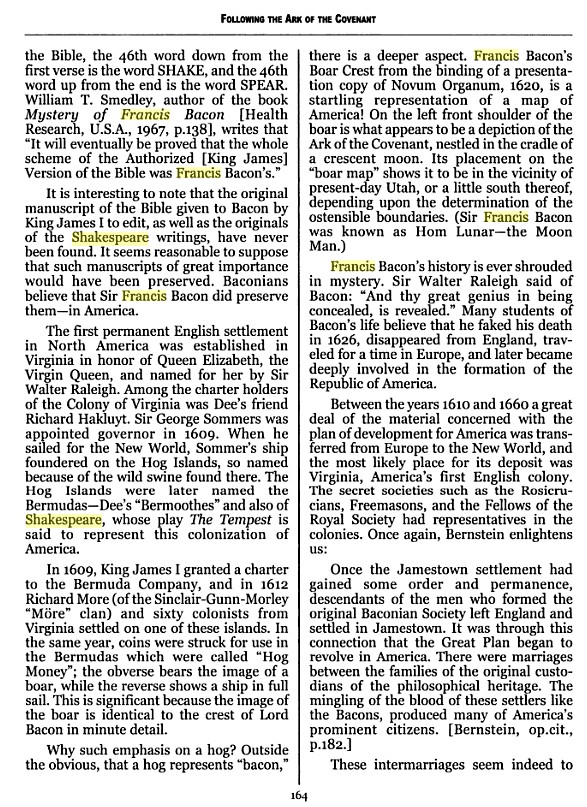
Regarding Kirkham and his connection to Oxford:
Costumes and Scripts in the Elizabethan Theatres - Jean MacIntyre
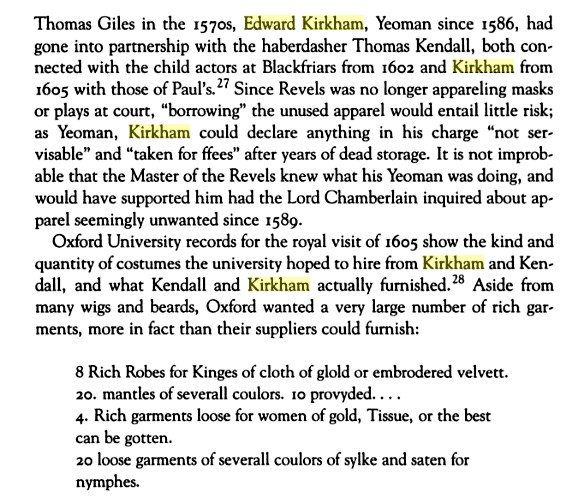
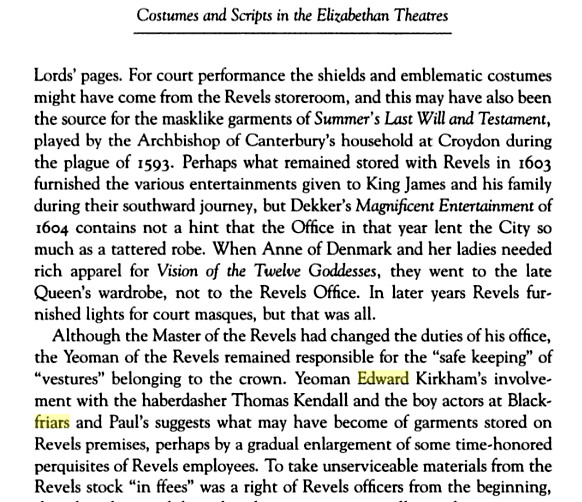
Here we establish that Edward Kirkham was "Yeoman of the Revels" and related to an Oxford Trustee:
PROB_11-122_f_230.pdf (applicationpdf Object)
On 31 January 1604 a grant was made to Edward Kirkham, Yeoman of the
Revels, Alexander Hawkins, Thomas Kendall and Robert Payne of a licence to train up children
to be called the Children of the Revels to the Queen (see Calendar of State Papers 1603-
1610, p. 72). It would appear from the will below that Edward Kirkham, Yeoman of the
Revels, was the cousin of Oxford’s trustee, George Kirkham, while Thomas Kendall was
a London haberdasher, and Alexander Hawkins was the son-in-law of Henry Evans (see
Munro, Lucy, Children of the Queen’s Revels: A Jacobean Theatre Repertory, (Cambridge: Cambridge University Press, 2005). For Edward Kirkham’s appointment as
Yeoman of the Revels by letters patent dated 28 April 1586, see Greg, Walter Wilson,
ed., Collections, Vol. II, Part III (Oxford University Press: Malone Society, 1931), pp.
339-41, available online
.
The will below states that Edward Kirkham's son, Robert Kirkham, was 'servant to the
right honourable the Earl of Salisbury', i.e. Oxford’s brother-in-law, Sir Robert Cecil.
Other contemporary documents also identify Robert Kirkham as one of Cecil’s
secretaries.
Master of the Revels - was the holder of a position within the English, and later the British, royal household, heading the "Revels Office" or "Office of the Revels". Originally he was responsible for overseeing royal festivities, known as revels, and he later also became responsible for stage censorship, until this function was transferred to the Lord Chamberlain in 1624.
Edmund_Tilney - (1536–1610) was a courtier best known now as Master of the Revels to Queen Elizabeth and King James. He was responsible for the censorship of drama in England. He was also instrumental in the development of English drama of the Elizabethan period. Tilney made the office of Master of the Revels into an institution.
So who was this prominent Henry Outlawe Gentleman in London who was involved with the Blackfriars Playhouse in the early 1600's??? Did he know Shakespeare?
1603/4-1609 - Henry Outlawe deposes on Edward Kirkham's behalf that for a total of fifteen weeks between 1603 and 1604, Henry Evans collected 30s a week 'for the use of stools standing upon the stage at Blackfriars.' Outlawe does not believe that Evans gave account of this income to the rest of the sharers. - Blackfriars - St Anne's - London - English professional theatre, 1530-1660
Amazing it seems Henry Outlawe is a
"gentleman" working with Thespians - just after QEI's death and the
beginning of James I.... :
It would seem he had to know Shakespeare... He testifies in 1609 about events in
1603 and 1604. Why was it that HE needed to testify?
Blackfriars Playhouse
... Shakespeare and the Blackfriars Theatre - The Elizabethan Playhouse
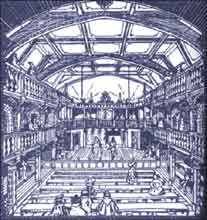 In 1600, Richard Burbage leased the Blackfriars to Henry Evans for 21 years for £40 per annum, but in August 1608, Richard Burbage took back the lease from Evans, and William Shakespeare and other King's men players became part owners of what was to become the Blackfriars Playhouse.
In 1600, Richard Burbage leased the Blackfriars to Henry Evans for 21 years for £40 per annum, but in August 1608, Richard Burbage took back the lease from Evans, and William Shakespeare and other King's men players became part owners of what was to become the Blackfriars Playhouse.
William Shakespeare bought a house a short walk away from Blackfriars theatre in Ireland Yard. The acting troupe performed at Blackfriars during the winter months while continuing to spend the summers at the Globe.
In 1619 the local residents again tried to close the theatre but due failed due to the intervention of the Privy Council.
...
The Blackfriars Playhouse Indoor Elizabethan Playhouse Theatre
The known facts about the Blackfriars Playhouse indoor Playhouse, which was used as one of the venues for English Elizabethan Theatre, are as follows:
London Location of the Blackfriars Playhouse indoor Playhouse - Ludgate Hill
The Blackfriars Playhouse indoor Playhouse was opened in - 1576
The famous people associated with the Blackfriars Playhouse indoor Playhouse were Richard Farrant, William Shakespeare and the Burbage family
...
Blackfriars Playhouse - originally a Dominican Monastery
The Blackfriars Playhouse Theatre was located in the City of London on the site of a dissolved 13th-century Dominican monastery.
The original Dominican monastery was built in 1275 and was located between the River Thames and Ludgate Hill.
...
The First Blackfriars Theatre
In 1538 the Dominican monastery of Blackfriars was closed due to the dissolution of the monasteries by King Henry
VIII. The monastery estates, which consisted of many different buildings on a vast area of land, were divided up and sold or leased.
In 1576, during the reign of Queen Elizabeth I, some of the buildings were leased to Richard Farrant who was Master of the boy choristers called the Children of the Chapel Royal. During the Elizabethan era the young boy members of the choirs were also encouraged to participate in drama. These troupes were called Children's companies. These children doubled as child actors and the buildings were used for play rehearsals and private performances prior to the 'Chapel Children' acting troupe performing at court. This was, therefore, the first Blackfriars theatre. The whole district retained the name and when the old refectory was turned into the theatre, the name was used to define its location. Plays were staged there until 1584 when the first 'Blackfriars Theatre' was closed due to various objections from City officials.
Also :
Hubert de Burgh, 1st Earl of Kent - (c. 1160 – before 5 May 1243) was Earl of Kent, Justiciar of England and Ireland, and one of the most influential men in England during the reigns of John and Henry III. ...After the death of William Marshal in 1219, Hubert de Burgh effectively became regent of England. In this position de Burgh acquired a number of enemies and rivals. ... He died in 1243 in Banstead, Surrey, England and was buried at the church of the Black Friars in Holborn.
English professional theatre, 1530-1660 - Glynne William Gladstone Wickham, Herbert Berry
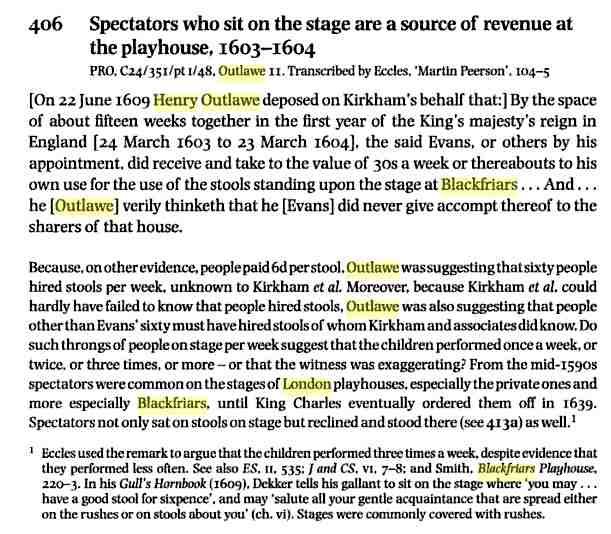
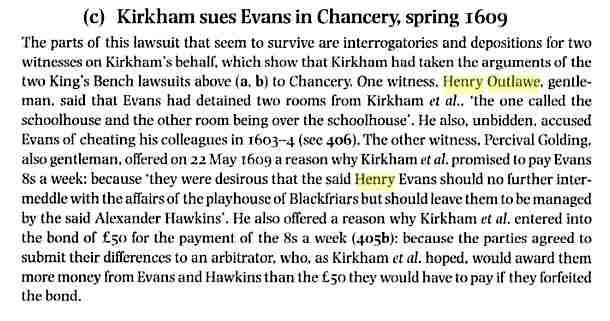
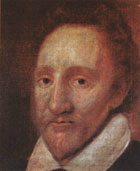 Luminarium Encyclopedia.
The Blackfriars Theatre.
Luminarium Encyclopedia.
The Blackfriars Theatre.
...
In 1596, another part of the old Blackfriars was bought by James Burbage,
owner of the Theatre and father of famed actor Richard Burbage, for £600
from the estate of Cawarden, late Master of Revels. This set of rooms, cellars,
and yards was near the Pipe office, next to the house of Sir George Cary. Burbage
spent an enormous sum to convert these rooms into a private indoor playhouse.
The residents of Blackfriars got an injunction against the theatre being used by
an adult troupe and Burbage had to lease the playhouse to children's
companies—around 1597, the Chapel Children are found in residence.
Richard Burbage, the principal actor with the Chamberlain's
Men, Shakespeare's company, inherited the second Blackfriars Theatre in 1597.
In 1600, he leased it to Henry Evans at an annual rate of £40, for a term of
21 years, and the children's performances continued. The Children of the Chapel
were renamed Children of Queen Anne’s Revels after the accession of James
I in 1603.
After the performance of Eastward Ho (1605), a collaboration between
Jonson, Marston, and Chapman, the Children lost their royal patronage,
because of a passage about Scots in Act III which offended King James so much
that he had the authors briefly imprisoned.
The playhouse ceased to be productive, and Burbage took back the lease from
Evans.
In 1608, Burbage, along with actors from his company, formed a company of
housekeepers, or owners, and began to use the playhouse. The King's Men, as the Chamberlain's
Men were now known, played at the Blackfriars during the winters. Later
works by Shakespeare, as well as works by Beaumont
and Fletcher, were
performed there.
In 1619, Blackfriars residents again tried to close the theatre, citing it as a
public playhouse, but the Privy Council intervened and confirmed its use. The
King's Men performed there without interruption until the closing of the
theatres with the English Civil War in 1642.
Bubonic Plague and Shakespeare
...
There were constant outbreaks of the Bubonic Plague and every time this occurred the Theatres were shut down. The closures occurred in 1593 , 1603 and 1608
In 1563, in London alone, over 20,000 people died of the disease - In 1665 the Great Plague of London again decimated the population of the town which killed 16% of the inhabitants (17,500 out of the population of 93,000)
The plague was not just confined to the towns. Nowhere was safe the same plague outbreak of 1563 claimed 80,000 people in England
From December 1592 until December 1593 Stow (the Elizabethan archivist) reported 10,675 plague deaths in London, a city of approximately 200,000 people.
In 1603, the plague killed 30,000 Londoners
Some other previous outbreaks of the plague in England were the 1636 plague, when some 10,000 had died, and the 1625 plague, when some 35,000 died
The Great Plague (1665–1666) was a massive outbreak of disease in the Kingdom of England (modern day United Kingdom) that killed an estimated 100,000 people, 20% of London's population
A chronicle history of the London
Stage 1559-1642 - Frederick Gard Fleay
...
From other papers also published by Mr. Greenstreet, and given in full farther on, additional particulars are ascertained, which require insertion here in a condensed form.
1597. July 15.—-N. Gyles gets his patent for the Chapel children, who no doubt acted under him at Blackfriars.
1600. Sep. 2.—-Richard Burbage let the Blackfriars building to H. Evans for 21 years from 1600, Sep. 29, Michaelmas.
1600. Dec.—Evans, Gyles, and Robinson entered on the "violent courses" mentioned in the document already given, in taking up children for their company.
1600. Dec-1601. Oct. 21.—During this interval, in the xliiith (three-and-fortieth) year of Elizabeth,
Evans was censured by the Star Chamber for his unorderly carriage in this matter, and all "assurances made to him concerning the said house or plays" were declared utterly void. The exact date was probably in April, certainly after the production of the Poetaster, and before the entry, S. R., of Cynthia's Revels, May 23. Jonson then left writing for the Chapel children, and returned to Henslow's company. Evans, finding it impracticable to carry on the Blackfriars Theatre with Gyles, &c., sought for new arrangements.
1601. Oct. 21.—Henry Evans let half the profits to Alexander Hawkins on trust for Edward Kirkham, William Rastell, and Thomas Kendall, on condition they should lay out £400, Hawkins being bound to reassign to these three men. This is Kirkham's statement; but Burbage says that the assignment to Hawkins, who, be it noted, was Evans'' son-in-law, was absolute, and that no trust deed existed to his knowledge. The three, according to Kirkham, paid Evans 8s. weekly, and Hawkins also paid Evans £$2, 10s, 0d. Why he should do this, if they took the whole benefit, does not appear.
1602. April 20.—In certain articles of agreement (according to E. Paynton's statement (we shall hear more of this gentleman in the next chapter) the above referred to lease was acknowledged to be in the absolute interest and possession of Hawkins, as it no doubt really was.
Kirkham was, as Jonson calls him in. his "Conversations," "a base fellow, and unworthy of credit."
2. The Paul's boys were not reinstated till 1600. They acted at their own singing-school. Their master was Edward Piers. See Marston's Jack Drum's Entertainment for date. It was acted in 1600, and was probably their first new play.
3. The Queen's men and the Earl of Sussex' appear, on the cessation of the Plague in December 1593, to have anticipated the other companies for a few months in recommencing. There are a few notices of them in "Henslow's Diary " as acting at the Rose until Easter 1594, which I have given above in the intercalatory section. After this
they disappear altogether from the London stage. From 1593 onwards only three men's companies were looked on as authorised in the liberties of the City, the Curtain having, in the view taken by the authorities, been replaced by the Fortune in 1600. Nevertheless, for a short time in 1599 it had been occupied by the Earl of Derby's men, who acted at Court 7th February 1600, and we hear of plays there on to 1601. In the next reign we shall find four men's companies fully recognised.
Interesting this Thomas Outlawe in 1493 seems to be the master Pewter'er in early 1500's but he also seems to know William Burbage and the Burbage family later becomes the great Shakespearian actor Richard Burbage whom Henry Outlawe may have known ....hmmm... Also there seems to be a connection to the earlier Cherteseye's and Checheley...
1492 - Thomas
Outlawe - 1 acre with a garden on the
southern boundary in Mattishall, the south head of which abutted onto the
King's highway
1493 - Inquisition
taken at the Guildhall - London, 23 March, 8 Henry VII [1493], before William
Martyn, Mayor and escheator, after the death of Edward Greene, by the
oath of John Machyn, Thomas Outlawe, John Gage, Thomas Couper, William
Wodestok, Henry Calvar, Thomas Rayner, Thomas Lybbys, Nicholas Jefray, William
Cambre, Richard Spycer, John Broune, John Knyght, Thomas Chamberleyn, and
Richard William - GUILDHALL
London - Guildhall,
London
1493 - Death of Ellen Wodeward witnessed by Thomas Outlawe - London - 23 March, 8 Henry VII
1497 - Death of Richard Chamberleyn witnessed by Thomas Outlawe - London - 4 March, 12 Henry VII - 1497
Abstracts of inquisitiones
post mortem relating to the city of London ... - Great Britain. Court of Chancery, London and Middlesex Archaeological Society
...
Inquisttion taken at the Guildhall, 23 March, 8 Henry VII [1493], before William Martyn, Mayor and escheator, after the death of Edward Greene, by the oath of John Machyn,
Thomas Outlawe, John Gage, Thomas Couper, William Wodestok, Henry Calvar, Thomas Rayner, Thomas Lybbys, Nicholas Jejray, William Cambre, Richard Spycer, John Broune, John Knyght, Thomas Chamberleyn, and Richard William, who say that
Cecilia, who was the wife of Robert Grene, knight, and late the wife of John Acton, was seised of a tenement called the Bell, situate in the parish of the Blessed Mary de Arcubus, which was late the property of the said Robert Grene, who held it in free burgage: it is worth per ann., clear, £6.
Elizabeth Grene, late the wife of Walter Grene, esq., John Pemberton, clerk, John Gayesford, John Catesby, and John Ardern were seised of a tenement situate in the parish of St. Thomas the Apostle in the ward of Vintrie, and so seised they demised the said tenement to fohn Doune, senior, citizen and mercer of London, for the term of 20 years from Michaelmas, 38 Henry VI [1460], at the yearly rent, for the 2 first years of the said term, of 5 marks, and for the other 18 years 10 marks. Afterwards, the said Elizabeth, John Pemberton, John Gaynes/ord, and John Ardern died, and John Catesby was alone seised of the said tenement: he had issue Humphrey Catesby, who after his father's death entered into the same tenement as his son and heir.
The said tenement is held in free burgage, and is worth per ann., clear, £4.
No other lands came into the hands of the King by the death of the said Cecilia, neither on account of the minority of
Edward Grene, her son and heir.
Edward Grene died 14 January last past; Cecilia, now the wife of William
Burbage, is his sister and heir, and is aged 26 years and more.
| - - - - -
Inquisition taken at the Guildhall, 23 March, 8 Henry VII [1493], before William Martyn, Mayor and escheator, after the death of Ellen Wodeward, widow, by the oath of John Machyn, Thomas Outlawe, John Gage, Thomas Couper, William Wodestok, Henry Calvore, Thomas Reyner, Thomas Lybbys, Nicholas Jeffrey, William Cambre, Richard Spicer, John Broune, John Kngyht, Thomas Chamberleyn, and Richard William, who say that
John Wodeward and the said Ellen, his wife, were seised of 24 messuages situate within the parish of All Saints of Berkyng, and so seised they enfeoffed thereof Thomas Chtcheley, son of the said Ellen: to hold to him and his heirs for ever. The said Thomas Chicheley still survives, and is seised of the premises as of freehold.
The said premises are held of James Underwode, Master of Whitingdon College in the City of London, but by what service the jurors know not; they are worth per ann., clear, 5 marks.
Ellen Wodeward died 1 July, 6 Henry VII [1491]; John Chicheley is her son and next heir, and is aged 40 years and more.
The name of Ellen Woodward's former husband is not given in the inquisition, but from the calendar it appears to have been Simon Checheley
we have more about the Blackfriars connection...
So who was this prominent Henry Outlawe Gentleman in London who was involved with the Blackfriars Playhouse in the early 1600's??? Did he know Shakespeare?
1603/4-1609 - Henry Outlawe deposes on Edward Kirkham's behalf that for a total of fifteen weeks between 1603 and 1604, Henry Evans collected 30s a week 'for the use of stools standing upon the stage at Blackfriars.' Outlawe does not believe that Evans gave account of this income to the rest of the sharers. - Blackfriars - St Anne's - London - English professional theatre, 1530-1660
Interesting - Blackfriars was first given to Sir Francis Bryan (who knew mariner Adam Owtlawe) by King Edward VI :
All the year round a weekly journal - Charles Dickens
King Edward the First and Queen Eleanor heaped many gifts on the sable friars. Charles the Fifth was lodged at their monastery when he visited England, and his nobles resided in Henry's new-built palace of Bridewell, a gallery being thrown over the Fleet and driven through the City wall to serve as a communication between the two mansions. Henry held the "Black Parliament" in this monastery, and hero Cardinal Campeggio presided at the trial which ended with the tyrant's divorce from the ill-used Katherine of Arragon. In the same house the parliament also sat that condemned Wolsey, and sent him to beg "a little earth for charity" of the monks of Leicester.The rapacious king laid his rough hand on the treasures of the house in 1538, and Edward the Sixth sold the Hall and Prior's Lodgings to Sir Francis Bryan, a courtier, afterwards granting Sir Francis Cawarden, master of the revels, the whole house and precincts of the Preacher Friars, the yearly value being then reckened at nineteen pounds. The holy brothers were dispersed to beg or thieve, and the church was pulled down, but the mischievous right of sanctuary continued.
And now we come to the event that connects the old monastic ground with the name of the great genius of England.
James Burbage, Shakespeare's friend and fellow-actor, and other servants of the Earl of Leicester, tormented out of the City by the angry edicts of over-scrupulous lord mayors, took shelter in the precinct, and there, in 1578, erected a play-house (Playhouse-yard).
Every attempt was in vain made to crush the intruders.
About the year 1586, according to the best authorities, the young Shakespeare came to London and joined the company at the Blackfriars Theatre.
Only three years later we find the new arrival (and this is one of the nnsolvable mysteries of Shakespeare's life) one of sixteen sharers in the prosperous though persecuted theatre. It is true that Mr. flalliwell has lately discovered that he was not exactly a proprietor, but only an actor receiving a share of the profits of the house, exclusive of the galleries (the boxes and dress circle of those days), but this is after all only a lessening of the difficulty, and it is almost as remarkable that a young unknown Warwickshire poet should receive such profits, as it is that he should have held a sixteenth of the whole property. Without the generous patronage of some such patron as the Earl of Southampton or Lord Brooke, how could the young actor have moved? He was twenty-six, and may have written Venus and Adonis or Lucrece, yet the first of these poems was not published till 1593. He may have already adapted one or two tolerably successful historical plays, and, as Mr. Collier thinks, might have written the Comedy of Errors, Love's Labour Lost, or the Two Gentlemen of Verona. One thing is certain, that in 1587 five companies of players, includingthe Blackfriars company, performed at Stratford, and in his native town Mr. Collier thinks Shakespeare first proved himself useful to his new comrades.
In 1589 the lord mayor closed two theatres for ridiculing the Puritans. Burbage and his friends, alarmed at this, petitioned the privy council, and pleaded that they had never introduced into their plays matters of state or religion. The Blackfriars company, in 1593, began to build n summer theatre, the Globe, in Southwark; and Mr. Collier, remembering that this was the very year Venus and Adonis was published, attributes some great gift of the earl to Shakespeare to have immediately followed this poem, which was dedicated to Southampton. That money may have gone to build the Globe.
By 1594, the poet had written Richard the Second and Richard the Third, and must have been recognised as a great writer.
In 1596, we find Shakespeare and his partners (only eight now) petitioning the privy council to allow them to repair and enlarge their theatre, which the Puritans of Blackfriars wanted to close. The council allowed the repairs, but forbade the enlargement. At this time Shakespeare was living near the Bear Garden, Southwark, to be close to the Globe. He was now evidently a thriving, "warm" man, for, in 1597, he bought for sixty pounds New Place, one of the best houses in Stratford.
In 1613, we find Shakespeare purchasing a plot of ground not far from Blackfriars Theatre, and abutting upon a street leading down to Puddle Wharf, "right against the king's majesty's wardrobe;" but he had retired to Stratford, and given up London and the stage before this. The deed of this sale was sold in 1841 for one hundred and sixty-two pounds five shillings.
Charles Dickens, Jan.] CHRONICLES OF LONDON STREETS. [November 4,1871.] 543
In 1608, the lord mayor and aldermen of London made a final attempt to crush the Blackfriars players, but failing to prove to the Lord Chancellor that the City had ever exercised any authority within the precinct and liberty of Blackfriars, their cause fell to the ground. The corporation then opened a negotiation for purchase with' Burbage, Shakespeare, and the other (now nine) shareholders. The players asked about seven thousand pounds, Shakespeare's four shares being valued at one thousand four hundred and thirty-three pounds six shillings and eight pence, including the wardrobe and properties, estimated at five hundred pounds. His income at this time Mr. Collier estimates at four hundred a year. The Blackfriars Theatre was pulled down in Cromwell's time, 1655, and houses built in its room.
| - - - - - -
Shakespeare’s property in Blackfriars
Val Hart, Assistant Librarian at Guildhall Library, unravels the history behind the Shakespeare deed, one of the City of London’s greatest treasures, which bears one of only six authenticated examples of Shakespeare’s signature.
I
Gyve . . . unto my Daughter Susanna Hall . . . All that Messuage or
ten[emen]te with th' appurtenances wherein one John Robinson dwelleth, scituat,
lyeing & being in the blackfriars in London nere the Wardrobe. With these
words William Shakespeare of Stratford upon Avon, gentleman, bequeathed to his
descendants the only property he is known to have owned in London. Why he
purchased it is not known. He may have intended to live there – it was
conveniently situated for both the Blackfriars Theatre and the Globe Theatre
just across the river – but there is no evidence to suggest that he ever did
so. It is more likely that he bought it as an investment or to enhance his
status as a gentleman.
Since 1843, when it was bought at auction by the Corporation of London for £145, the title deed to Shakespeare’s Blackfriars property has been one of the City’s greatest treasures. Although it is the vendor’s, not the purchaser’s copy – Shakespeare’s copy is in the Folger Shakespeare Library in Washington – the deed bears one of only six “authenticated” examples of Shakespeare’s signature.
The deed describes the property purchased in some detail:
All that dwelling house or Tenement with th’appurtenaunces situate and being within the Precinct, circuit and compasse of the late black Fryers London, sometymes in the tenure of James Gardyner Esquiour, and since that in the tenure of John Fortescue gent, and now or late being in the tenure or occupacion of one William Ireland or of his assignee or assignes; abutting upon a streete leading downe to Pudle wharffe on the east part, right against the Kinges Maiesties Wardrobe; part of which said Tenement is erected over a great gate leading to a capitall Messuage which sometyme was in the tenure of William Blackwell Esquiour deceased, and since that in the tenure or occupacion of the right Honorable Henry now Earle of Northumberland; And also all that plott of ground on the west side of the same Tenement which was lately inclosed with boordes on two sides thereof by Anne Bacon widowe, soe farre and in such sorte as the same was inclosed by the said Anne Bacon, and not otherwise, and being on the third side inclosed with an olde Brick wall; Which said plott of ground was sometyme parcell and taken out of a great peece of voide ground lately used for a garden.
The deed of purchase is dated 10 March 1613 and was made between the vendor, Henry Walker, Citizen and Minstrel of London on the one part, and William Shakespeare, William Johnson, Citizen and Vintner of London and John Jackson and John Hemmyng, both described as gentlemen of London, on the other part. Shakespeare was the sole purchaser; the men named with him acted as trustees. It is tempting to equate Johnson with the landlord of the Mermaid Tavern in Cheapside and Hemmyng with John Heminges, actor, manager and editor of the Shakespeare first folio, but the identity of John Jackson remains uncertain.
On the following day (11 March 1613) Shakespeare executed another deed stipulating that £60 of the purchase price was to remain on mortgage until paid in whole the following September. Whether this sum was ever paid is not known.
After
the dissolution of the Blackfriars monastery in 1538, its land and buildings had
been parcelled out to ambitious courtiers. The estate of which
Shakespeare’s property formed part was granted in 1547 to Sir Francis Bryan,
dubbed “The Vicar of Hell” by Thomas Cromwell.
After Bryan’s death in 1550 it came into the hands of Thomas Thirlby, Bishop of Norwich, later Bishop of Ely, who then sold it to William Blackwell, Common Clerk of the City of London.
In 1590 the estate was divided between two of William’s children, William Blackwell junior and Anne Bacon. Anne’s portion contained the gatehouse property, and in 1604 her son Mathie (also called Matthew or Mathias) Bacon, sold this part of the estate to Henry Walker for £100. Later the same year Walker leased the gatehouse to William Ireland, Citizen and Haberdasher of London, for 25 years.
The exact date at which Shakespeare’s property passed out of the hands of his descendants is not known, but in August 1667, Edward Bagley, a kinsman of Shakespeare’s grand-daughter, Elizabeth Barnard, sold the site to Sir Heneage Fetherston. As the Blackfriars area had been razed to the ground by the Great Fire of the previous year, Bagley received only £35 for the land.
Despite the detailed description in the deed it has proved difficult to locate the exact site of Shakespeare’s property. We know that it abutted on the street leading down to Puddle Wharf which is now St Andrew’s Hill. The Wardrobe which it was near or “right against,” is commemorated in Wardrobe Place. However, even the Shakespearean scholar James O. Halliwell-Phillipps, who owned an abstract of title to Fetherston properties in Blackfriars (now in the Folger), could arrive at no firmer conclusion than that the gatehouse property stood either partially on or very near Ireland Yard. The present day passage of this name, which runs west out of St Andrew’s Hill, undoubtedly derives its name from the Ireland family who owned or occupied property in the Blackfriars area at least as early as 1582. Deeds, plans and the Folger abstract of title suggest that Shakespeare’s property may have occupied the north side of Ireland Yard where it joins St Andrew’s Hill, but this is still research in progress.
Interesting we found Henry Outlawe in London 1603-1609 now I find a William Outlaw in 1614 involved with James I's "closet" clergy circle:
1601 - WILLIAM OUTLAWE matriculated Emmanuel College, 1601. - Emmanuel College, Cambridge - a college of training for Protestant preachers to rival the successful Catholic theological schools
1614 - March 6. Statement by Leonard Rountree of four articles to prove the superiority of the Protestant over the Romish faith, which were sent to him by Dr. Favour; of his replies thereto; and conversations upon them with William Outlaw, Mr. Burton, and Mr. Harwood.
1618 - Rountree, Leonard - Perpetual Vicar - St Peters, Isle of Thanet - Canturbury Kent - dies 1625 - Isle_of_Thanet - A memorial for Mr. Leonard Rowntree, minister, obt. 1624
This William maybe the son of Richard Outlawe the "noted" pursuivant (priest hunter). This record does seem to be regarding this.
Calendar of State Papers, Domestic ... - Great Britain. Public Record Office
Domestic - James I - 1614
March 6. 41. Statement by Leonard Rountree of four articles to prove the superiority of the Protestant over the Romish
faith, which were sent to him by Dr. Favour; of his replies thereto; and conversations upon them with
Wm. Outlaw, Mr. Burton, and Mr. Harwood. Imperfect. [Seemingly written from prison and for
publication.]
March? 42. L[eonard] R[ountree] to Matthew Kellison, President of [Douay] College.
Explains, at his request, his opinions on divers points of Romish doctrine and discipline. Latin.
Generally - "Mr. denotes a knighted or "a peer" person ( or an equal ) So "Mr. Harwood" maybe Sir Edward Harwood who is mentioned elsewhere. William Outlaw is probably a "gentleman" but not "a peer"
| - - - -
Mr Harwood seems to be Sir Edward Harwood who fought later for the Dutch... and seemed to be close to James I and often discussed religious matters....
Calendar of State Papers, Domestic ... - Great Britain. Public Record Office - Google Books
1617 - Sir Edw. Harwood to the Same. Lady Bedford greatly indebted to Lady Carleton for her present. Next term the Earl of Suffolk and Sec. Lake are to receive their doom; their successors are not known. Lady Buckingham still in the country, and it is thought her late honour was a preparative to retire. The Queen is better.
Dec 5
Dec. 20. Sir Edw. Harwood to the Same. The King just returned London. from Theobalds. Mr. Secretary thinks
a synod a bad way to end religious dissensions, but says the King will countenance it; so say the Archbp. of Canterbury and Lord
Chamberlain
Dec. 22. Sir Edw. Harwood to Carleton. Sounded Sec . Lake and Monday. Buckingham upon Carleton's advancement, but both are cool about n on. it. Delivered his letter to the King, who spoke much on the importance of unity in religion, and declared he would believe nothing the Armenians said, except what came direct from Carleton; that be did not, like many Princes, do his business through others, but opened all his packets himself, and none dared reply to them but by his dictation; that he approved of his Excellency [the Prince of Orange's] using all legal means to put down the Arminians, especially his calling a national synod, and would advise him to do as he himself had done, call dissentients before him to maintain their opinions in his presence. His Majesty spoke favourably of him [Carleton]. Buckingham disapproves of his wish to come over, if he come in hopes of a place; he intends to have his own kinsman, Sir Robt. Naunton, made Secretary.
1624 - Married Thomas Wright, of Ripon, and Jane Outlawe, widow, of St. Michacl-le-Belfrey, York
| - - - -- -
Arminianism -
(also called Reformed Arminian tradition, the Reformed Arminian faith,
or Reformed Arminian theology) is a school of soteriological
thought within Protestant
Christianity
based on the theological
ideas of the Dutch
Reformed theologian Jacobus
Arminius (1560–1609)[1]
and his historic followers, the Remonstrants.
The doctrine's acceptance stretches through much of Christianity from the early
arguments between Athanasius
and Origen, to Augustine
of Hippo's defense of "original
sin."
Dutch Arminianism was originally articulated in the Remonstrance (1610), a theological statement signed by 45 ministers and submitted to the Dutch states general. The Synod of Dort (1618–19) was called by the states general to pass upon the Remonstrance. The five points of the Remonstrance asserted that:
The crux of Remonstrant Arminianism lay in the assertion that human dignity requires an unimpaired freedom of the will.[2]
Since the 16th century, Christians of many sects including the Baptists (See A History of the Baptists Third Edition by Robert G. Torbet) have been influenced by Arminian views. So have the Methodists, the Congregationalists of the early New England colonies in the 17th and 18th centuries, and the Universalists and Unitarians in the 18th and 19th centuries.
Jacobus Arminius - 1 (October 10, 1560 – October 19, 1609), the Latinized name of the Dutch theologian Jakob Hermanszoon from the Protestant Reformation period, served from 1603 as professor in theology at the University of Leiden. He wrote many books and treatises on theology, and his views became the basis of Arminianism and the Dutch Remonstrant movement
| - - - - -
descendants of Sir George Harwood of London England
Sir Edward Harwood [140275] Virginia Company shareholder in Virginia before 1622 b.1586 d.11_Sep_1637
1632 Memorial to Sir Edward Harwood
Sir Edward Harwood died at the siege of Maastricht in 1632
Memorial on the east wall within the Cloister Church at the Hague, where Sir Edward has been buried.
The original text is in Latin, the monument has been erected in 1636 by Sir
Henry Herbert and Nicholas Byron
English translation by David Trim
Thou that lookes on mayest be a stranger!
Here is buried Whatever was perishable of the soldier
Sir Edward Harewood, an Englishman,
A Knight, deriving his origin from Norfolk, who under very powerful
generals, as a common soldier,
At the siege of Bommel (1599) first saw service, And was made Ensign at Ostend
(1602);
At the storming of the Rhinberg (1606)
He became Lieutenant: after that,
Of the Regiment of English commanded by the Illustrious Sir Robert Sidney
Viscount de Lisle, He was made Lieutenant-Colonel.
In Fine After serving 33 years At the siege of Maastricht
He was pierced through by three successive bullets,
and died whilst in the discharge of his duty.
That part of him which was Imperishable (that he was a man brave as well as
good, Most devoted to his God and Country)
Is handed down to the recollection and for the example of posterity, by Henry
Herbert and Nicholas Byron,
Both Knights The former Colonel, and the latter Captain in the English Army. A.
D. 1636.
| - - - - -
Mr. Burton was probably Henry Burton :
Henry Burton (Puritan) - (Yorkshire, 1578 – 1648), was an English puritan. Along with John Bastwick and William Prynne, Burton's ears were cut off in 1637 for writing pamphlets attacking the views of Archbishop Laud.
He was educated at St. John's College, Cambridge, where he graduated M.A. in 1602.[1] His favourite preachers were Laurence Chaderton and William Perkins. On leaving the university he became tutor to two sons of Sir Robert Carey.
Through the Carey interest, Burton obtained the post of clerk of the closet to Henry Frederick, Prince of Wales; while acting in this capacity he composed a treatise on Antichrist, the manuscript of which was placed by the prince in his library at St. James's. He complains that Richard Neile, who was clerk of the closet to King James, opposed his advancement; however, on Prince Henry's death (6 November 1612) Burton was appointed clerk of the closet to Prince Charles. On 14 July 1612 he had been incorporated M.A. at Oxford, and was again incorporated on 15 July 1617. He tells us that at the age of thirty (i.e. in 1618) he resolved to enter the ministry. Thomas Fuller says that he was to have attended Prince Charles to Spain (17 February 1623) for the Spanish Match, and that for some unknown reason the appointment was countermanded.
Clerk of the Closet - Clerks of the Closet in other Royal Households
| - - - -
1624 - Married Thomas Wright, of Ripon, and Jane Outlawe, widow, of St. Michacl-le-Belfrey, York ( possible connection to Dr. John Favour )
St Michael le Belfrey, York - The present church building was built between 1525 and 1536 and replaced a church that dated back to at least 1294.
The church is famous for being the place where Guy Fawkes was christened on 16 April 1570 Fawkes was christened an Anglican but later converted to Catholicism which led to the failed 1605 Gunpowder Plot
Fountains Abbey - is near to Aldfield, approximately two miles southwest of Ripon in North Yorkshire, England. It is a ruined Cistercian monastery, founded in 1132. Fountains Abbey is one of the largest and best preserved Cistercian houses in England.
| - - - - - - - -
John Favour - (d. 1624) was an English divine.
Favour was born at Southampton, and was sent to Winchester College, whence he was elected probationer fellow of New College, Oxford, in 1576, and in 1578 was made complete fellow. In April 1584 he took the degree of LL.B.[1], proceeding LL.D. on 5 June 1592 (ib. i. 258). In January 1593–4 he became vicar of Halifax, Yorkshire.
In August 1608 according to Thoresby[2], but in March 1618 according to Wood, he was made warden of St. Mary Magdalen's Hospital at Ripon, Yorkshire. He was made prebendary of Southwell in 1611 and of Osbaldwick, York, in 1614. In March 1616–17 he was collated to the prebend of Driffield and to the chantorship of the church of York. He was also chaplain to the archbishop and residentiary.
Century of Revolution - A Puritan stronghold, Halifax suffered occupation by both Royalist troops after the Royalist victory at Adwalton Moor in 1643 and by Parliamentarian forces after the Royalist defeat at Marston Moor.
Dr John Favour’s energetic and inspiring ministry as Vicar of Halifax from 1593 to 1623 promoted the growth of Puritanism in the parish and an upsurge in charitable bequests including the endowment of Heath Grammar School
| - - - - -
Leonard Rountree was a Jesuit priest that went over to the Church of England..... A propaganda tool
Leonard Rountree - Conversion, politics, and religion in England, 1580-1625 - Michael C. Questier

So just to recap I have found two possible original fathers of Captain John Outlaw and Edward Outlaw
Henry Outlawe - Gentleman - Blackfriers playhouse - London - 1603-1609
William Outlaw - King James I Domestic papers - London - Clergy puritan
with Henry Burton "clerk
of the closet" to Prince
Charles in 1614 (this may have been the son of Richard Outlawe the
Pursuivant.)
However since both John and Edward were involved with ships and ship building I think the father was probably was someone else (possibly from Stepney or Bridge Kent)_. There was plague at the time and we have Mary Outlawe as widow, we might presume she had children.
1601 - WILLIAM OUTLAWE matriculated Emmanuel College, 1601.
1602 - Smyth, John, of Bridge, and Mary Outlawe (widow), Nov. 27 -Canterbury marriage licences
1603/4-1609 - Henry Outlawe deposes on Edward Kirkham's behalf that for a total of fifteen weeks between 1603 and 1604, Henry Evans collected 30s a week 'for the use of stools standing upon the stage at Blackfriars.' Outlawe does not believe that Evans gave account of this income to the rest of the sharers. - Blackfriars - St Anne's - London - English professional theatre, 1530-1660
1609 - William Vynor & Mary Outlawe - Dec 19 - Marriages at St. James - Clerkenwell
St James's Church, Clerkenwell
- Old Church of St James: 1540 - 1788 - At the dissolution of the nunnery under Henry VIII its church, which by then seems to have
acquired a second dedication to St James, was taken into use by its parishioners who had already been using a part of it for some considerable time.
The site of the nunnery was granted to Thomas Howard, 3rd Duke of Norfolk in 1540 but the freehold of the church passed through various hands until it was conveyed in 1656 to trustees on behalf of the parishioners, who at the same time obtained the right to appoint the vicar. Unlike other parishes, they retained it after the Restoration of 1660.
- The Monastic Order of the Knights
Hospitallers of St
John of Jerusalem
had its English
headquarters at the Priory
of Clerkenwell.
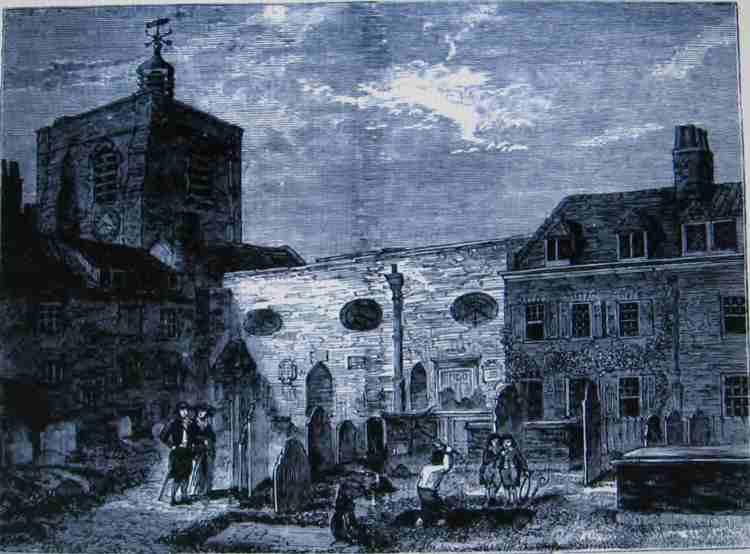
The National Archives Access to Archives - Sched excom - They seem to be clustered in 1609 1614 and 1617
1614 - March 6. Statement by Leonard Rountree of four articles to prove the superiority of the Protestant over the Romish faith, which were sent to him by Dr. Favour; of his replies thereto; and conversations upon them with William Outlaw, Mr. Burton, and Mr. Harwood.
1617 - Sched
excom: Thos OUTLAWE Bridge Kent; non-appearance - 6 May 1617
- Canterbury Cathedral [ A Puritan! ]
1617 - Hornsey,
Richard, of Bishopsbourne, miller, and Mary Outlawe of Bridge, St.
Margaret's, Cant. Isaac Outlawe of Bridge, husb., bonds. Canterbury
Marriage licences- Nov. 9
1617 - Indenture
of convenant to levy a fine relating to lands in Burnby - Witnesses:
Henry Outlawe, Desmond Fortescue, Robert Scruton - 22 Jul 1617 -
East Riding of Yorkshire
Notice this! Puritans were being excommunicated from the church of England. Many left for Holland and then on the Mayflower:
Mary Chilton
-
1609, James wife was excommunicated from St. Peter's Church, Canterbury,
England
1610, Moved to Leyden, Holland to escape religious prosecution
1620, James and wife were passengers on Mayflower
James Chilton - (c. 1556 – 18 December 1620) was an English Separatist who came to America aboard the ship Mayflower. He was a signer of the Mayflower Compact, and was probably the oldest Mayflower passenger. ... James Chilton died on 8 December 1620, while the Mayflower lay anchored in Provincetown Harbor
The first evidence that the Chilton family had its own Separatist views appears in 1609. In late April, Chilton's wife was among four people that secretly buried a dead child, without having the Church of England perform its mandatory burial rites. When the burial was discovered, the group rejected the need for the mandatory rites, calling them "popishly ceremonies and of no other force." For this defiant act, Chilton's wife and two of the others were excommunicated from the Church of England on 12 June 1609
1624 - Married Thomas Wright, of Ripon, and Jane Outlawe, widow, of St. Michacl-le-Belfrey, York
| - - - - - - - -
To continue with the Mayflower connection to the Outlawe's (we seem to be one connection removed and more connected to the Virginia Colony company)
The Finding of the Mayflower
- The Fourth Owner of the "Mayflower" Found.
We have shown in what precedes that the Jordans farm with its attached ship-built barn was the property
of the Gardiner family, and that it passed from them to the Russell family at some time in the middle of the
seventeenth century ; and we have suggested that there may have been some connection between
the Gardiner clan and a certain Richard Gardiner who sailed in the 41 Mayflower ". At this point we find ourselves in
difficulties ; for the name Gardiner is a common one, but the Gardiner clan, whom we have been detecting among
the owners of Jordans farm, does not crop up in the Chalfonts, in the same way as the Child clan does in the
district round Amersham. We must go outside the county in search of their ancestry.
We showed in the previous chapter from an inquisition made on 21 January, 1541/2 that William Gardyner was at his death the owner of the Manor of Grove Place and, amongst other properties, of the Jordans farm
Brothers = John Newdigate, Frances Newdigate, and James Bacon, William Godolphin,
Brothers- John Gardiner, Thomas Newdegate, in-law Antony Newdegate, Nicholas Newdegate, Robt. Newdegate.
Cousin = Richard Crayford, to whom the testator
Witnesses ; John Newdegate, Edward Baber, Thomas Newdigate, John Gardiner, Will. Godolphin,
John Greene.
Date of Probate : 26 Nov. 1561.
1543 - Westminster., 19 Feb. showing Sir Francis Bryan that the King is advertised of the troubles we were in upon the seas and the danger and ruin of his ships, and that I was determined according to your commandment to send four ships to the Downes. The said ships were ready in Humber before the receipt of your letters, whereupon I sent a boat which has spoken with Mr. Clere and Mr. Carye, commanding them to lie off and on upon the coast between Humber and Newcastle, and as Mr. Nedygate and Adam Owtlawe were ready victualled I thought it more convenient that they should accompany Mr. Clere and Mr. Carye, than lie in harbour.
Mr. Nedygate is probably Thomas Newdegate - a relative of John Newdegate Esq. of Harefield, (or more likely his son John Newdegate Esq.) born 6 Henry VII; dying in 1545 was succeeded by his eldest son. John Newdegate Esq. of Harefield MP for Middlesex in 1571, 1573, 1574
As an interesting aside there are records in the Shakespeare library regarding wills of properties Stratford-upon-Avon - Does this relate to the earlier Henry Outlaw? (see research page 2 and 4 ) connection to Richard Burbage?
Here are those links:
Contents:
Copy of the will of John Lord of Stratford-upon-Avon, gent., whereby he
devised to his friends John Whitehead of Barford, Jeffery Bevington Lowe of
Eatington and Robert Bell Wheler of Stratford-upon-Avon., gent., of all his real
and personal property upon trust for his wife Ann for her life and thereafter as
to and concerning his freehold and leasehold property to convey to his cousin
William Lord of Shipston-upon-Stour his messuage with appurtenances called the
Falcon situate at the southwest corner of Chapel Street then in the tenure of
widow Ashfield and also a piece of garden ground in Scholars Lane and to convey
to his cousin Elizabeth Lord, sister of the said William Lord, the messuage
wherein he then dwelt (thereto-fore Frensham's) in Chapel Street with garden and
appurtenances; also another messuage with appurtenances on the southside of, and
adjoining to, the last in Chapel Street then in the occupation of Mrs. Taylor;
also to convey to his cousin Mary Bellamy, sister of the said William and
Elizabeth Lord and wife of John Byrkin Bellamy of Shipston-upon-Stour, gent.,
four messuages with gardens and appurtenances in Swine Street, then in the
occupation of William Tims and others, also four messuages with appurtenances in
the Rother Market adjoining the lane leading from the Birmingham and Alcester
Roads into the Evesham Road, which last mentioned messuages the testator
theretofore erected upon the site of the barn and yard which he purchased with
Rowley Grounds from William Brook Smith, and the testator directed that his
trustees and executors should pay the rents and profits of grounds called Rowley
Grounds in the parish of Old Stratford adjoining the Stratford to Warwick
turnpike road which he theretofore purchased of William Brook Smith, and also of
two leasehold messuages with warehouses and appurtenances in St. Paul's Square,
Birmingham, which the testator theretofore purchased from the executors of his
wife's late brother, William Eaves of Stratford-upon-Avon, deceased, to Mrs.
Elizabeth Davenport Hobbes of Stratford-upon-Avon, widow of Robert Hobbes,
deceased, for her life and after her death to hold the same in trust for the
child or children of the said Mrs. Hobbes equally and upon further trust to pay
the rents and profits of several leasehold messuages in Shutt Lane, Park Street
and Canal Street, Birmingham, which premises were also purchased by the testator
of the executors of the said William Eaves, to the testator's wife's nephew Thomas
Wardell of Sutton Coldfield for his life and thereafter to hold the same upon
trust for the child or children of the said Thomas
Wardell equally, and as to and concerning the testator's personal estate (after
the death of his said wife) he made bequests to be paid to the children of
William Brooks of ER60/6 Clements Row, Milk Street, Cheapside, London, by Eliza
or Elizabeth his wife, who was a daughter of the testator and then lately
deceased, to his daughter Mary, wife of Moses Backhouse of Coventry, dealer in
glass and earthenware, and her children; to John Hathaway Turbitt of Halford,
gentleman, to Mary and Ann the twin daughters of the Rev. Robert Outlaw
of Brockton, Salop, clerk, to Frances, Anne, Elizabeth and Mary, the four
daughters of Richard Wyatt of Stratford-upon-Avon, gentleman, to the
treasures of the General Hospital at Birmingham; to the said John Whitehead,
Jeffery Bevington Lowe and Robert Bell Wheler and to his servants and he
directed his said trustees to hold the residue of his said personal estate upon
trust to divide the same between the children of the said Mrs. Elizabeth
Davenport Hobbes living at the testator's decease equally and the testator
appointed the said John Whitehead, Jeffery Bevington Lowe and Robert Bell Wheler
to be his executors.
Witnesses: Catherine Hitchcocks, Mary Hitchcocks and Elizabeth Hitchcocks.
Proved at London 2nd October 1827 by all the said executors. 9 f.
Contents:
Copy probate of the will 23 Feb. 1822 of John Lord of Stratford-upon-Avon,
gent., bequeathing all his real and personal estate to trustees for the
benefit of his wife, Ann Lord, for life, and, after her death in trust as
follows:
- to convey to his cousin, William Lord of Shipston-on-Stour his messuage in
Chapel Street, Stratford-upon-Avon, called the Falcon, now in the tenure of
Widow Ashfield, and a piece of garden in Scholars Lane now in the testator's
possession
- to convey to his cousin, Elizabeth Lord, sister of William Lord, a messuage
"(heretofore Meacham's)" in Chapel Street wherein the testator now
lives, and another messuage adjoining the last on the south side, now in the
tenure of Miss Taylor
- to convey to his cousin, Mary Bellamy, sister of Elizabeth and William Lord
and wife of John Byrkin Bellamy of Shipston-on-Stour, gent., his four tenements
in Swine Street, now in the tenures of William Tims and others and his four
messuages at the back of the Rother Market, built on land purchased from Mr.
Brook Smith, in the several tenures of --- Court and others.
- to pay to Mrs. Elizabeth Davenport Hobbes for life the income from several
inclosed grounds called the Rowley Grounds in Old Stratford near the Warwick
Road, purchased from Mr. Brook Smith, and from two leasehold messuages in Saint
Paul's Square, Birmingham, purchased from the executors of his late wife's
brother, William Eaves of Stratford-upon-Avon
- to pay to his late wife's nephew, Thomas
Wardell of Sutton Coldfield, for life, the income from his leasehold messuages
in Shut Lane, Park Street and Canal Street, Birmingham, also purchased from the
executors of William Eaves.
- to pay pecuniary legacies to the six children of William Brooks of
Cheapside, London, by Eliza, the testator's natural daughter; his natural
daughter Mary, wife of Moses Backhouse of Coventry, dealer in glass and
earthenware; John Hathaway Turbitt of Halford, gent.; Mary and Anne, twin
daughters of the Reverend Robert Outlaw
of Brockton, co. Salop., clerk; Frances, Anne, Elizabeth and Mary, the four
daughters of Richard Wyatt of Stratford-upon-Avon, gent.
Contents:
Will of Thomas Chapman Sheldon, dated 15 July 1829, with the following
bequests:
i) to trustees, James George and Septimus Sutton Lowe of Stratford-upon-Avon,
leasehold messuage and adjoining freehold garden ground and buildings in Rother
Street in the tenure of John Mills Esq., in trust to sell and divide the money
between the children of Richard Bartlet by his Aunt Peggy his wife
ii) to his cousin, Richard Corbett of Quinton (son of Michael Corbett by his
late aunt Elizabeth) his lands at Bretforton now occupied by.... Rimell charged
with certain annuities
iii) to his said trustees his several freehold messuages in Henley Street and
Meer Pool Lane occupied by.... Cross and others and his leasehold messuage
called the George and Dragon in Henley Street now occupied by Thomas Chandler,
in trust to sell and divide the money between his cousins, Elizabeth and Mary
Corbett, sisters of the said Richard Corbett
iv) to Rebecca Corbett, another sister of the said Richard, a freehold messuage
in Ely Street in the tenure of William Thompson
v) to James George a freehold messuage in Ely Street occupied by Miss Outlaws,
a freehold tenement in High Street in the tenure of himself and his co-partner,
James George, and his freehold land in Old Stratford; to hold for life with
reversion to the said Rebecca Corbett
The Project Gutenberg - Shakespeare's Family, by Mrs. C. C. Stopes.
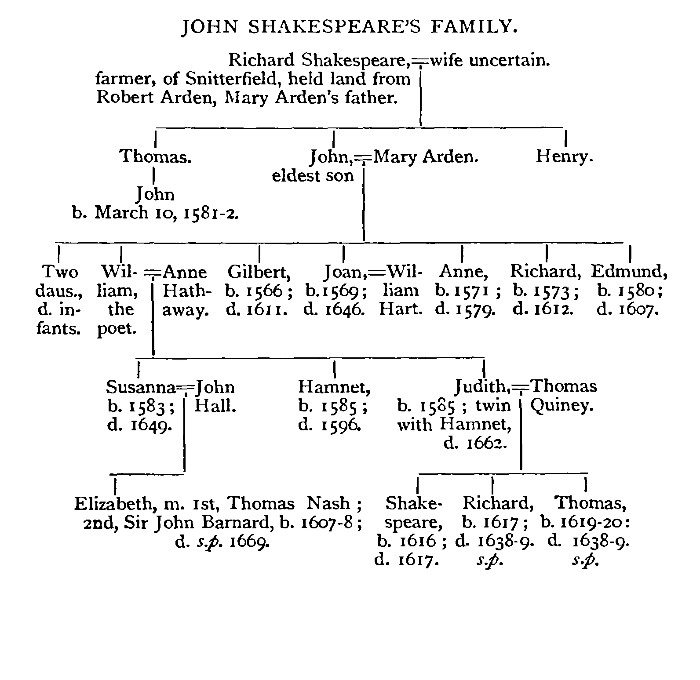
1593 - To Ric. Owtlaw, pursyvaunt, for arestinge Mr. Arch deacon of York in the church of York upon a tachment - ** A singular incident. The Archdeacon of York, Robert Ramsden, a notorious person, has a writ served upon him in the minster at the suit of the Chapter
Robert Ramsden, Archdeacon of York and chaplain to Lord Burghley - William Cecil
William Cecil, 1st Baron Burghley - died 4 August 1598) was an English statesman, the chief advisor of Queen Elizabeth I
Henry Savile (Bible translator) - He was the son of Henry Savile of Bradley, near Halifax in Yorkshire, England, a member of an old county family, the Saviles of Methley, and of his wife Elizabeth, daughter of Robert Ramsden.... In 1578 he travelled on the continent of Europe, where he collected manuscripts and is said to have been employed by Queen Elizabeth as her resident in the Low Countries.
On his return he was named Greek Tutor to the Queen, and in 1585 was established as Warden of Merton by a vigorous exercise of the interest of Lord Burghley and Secretary Walsingham.
On 26 May 1596 he obtained the provostship of Eton, the reward of persistent begging...
In February 1601 he was put under arrest on suspicion of having been concerned in the rebellion of the Earl of Essex. He was soon released and his friendship with the faction of Essex went far to gain him the favour of James I.
George
Durant - was in Northumberland (later Westmoreland) County,
Virginia by 1650 or before. He would have been about eighteen years old in 1650.
By trade, Durant was a "marriner" - as attested in his will
dated 9 Oct 1688. The earliest sailing voyage that is documented for George
Durant was in 1658, when he sailed aboard the Patomack Mecht, commanded
by Robert Clarke. Young George Durant was about twenty-five years old at the
time. The Patomack Mecht was possibly of Dutch construction and sailed
from Virginia to Holland with a cargo of tobacco and other goods. We know of
this voyage because there is a court case associated with the thirty hogsheads
of tobacco stowed on board
...
In the year of 1658, he joined a party composed of John Battle, Dr. Thomas Relfe,
Roger Williams, Thomas Jarvis, John Harvey, John Jenkins and others to explore
and settle the wilderness of the Albemarle - which was then a frontier of
Virginia called Roanoke
...
The land chosen by Durant still bears the name of Durant's Neck (formerly
known as Wikacome) and is located on a point of land bordered by Roanoke
Sound (now Albemarle Sound) in southern Perquimans County. Perquimans means
"land of beautiful women" and was named by the Yeopim Indians.
...
By 1662, Durant had already built a house and had cleared a part of the
land.
A year later, the governor of Virginia (Sir William Berkeley) told all settlers who had obtained land from the Indians that they must now obtain grants from Virginia.
...
To circumvent the Navigation Acts, Albemarle merchants began smuggling. The New England coastal traders opened a profitable illegal trade with the Carolina planters. Tobacco was carried by sloop to Boston. From there it was transported to heavy ships bound for Scotland, Ireland, Holland, France, and Spain. England quickly caught on to the fact that they were losing valuable customs revenue and retaliated by passing the Plantation Duty Act in 1673. This act stated that colonial ships leaving port had to pay customs duties prior to sailing. Parliment appointed customs officials in Albemarle to collect the duties
 The
Durant Family Bible is one of the oldest English Bibles in the USA. It
is displayed at the University
of North Carolina at Chapel Hill in a locked cabinet. The Bible was printed
in London, England in 1599. He brought this Bible with him when he came to the
New World.
The
Durant Family Bible is one of the oldest English Bibles in the USA. It
is displayed at the University
of North Carolina at Chapel Hill in a locked cabinet. The Bible was printed
in London, England in 1599. He brought this Bible with him when he came to the
New World.